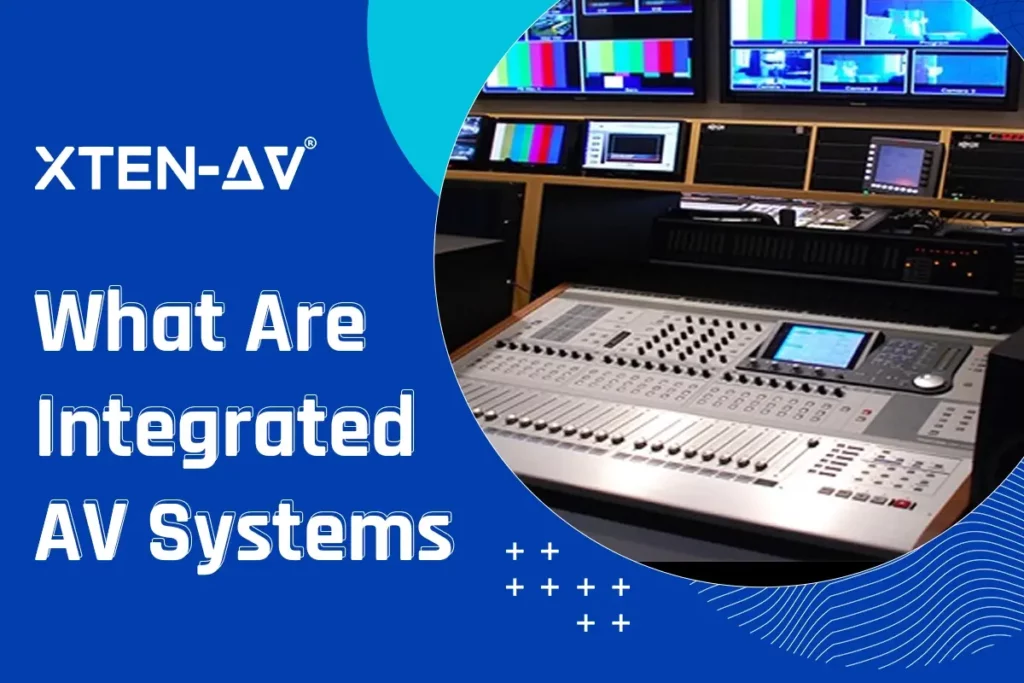What Are Integrated AV Systems: Understanding the Basic in Detail!
Whether you’re outfitting a corporate office, a school, or a home, the right AV system setup can make a significant difference. The process of AV system installation involves more than just plugging in devices; it requires careful planning and professional AV solutions to ensure smooth integration and optimal performance.
With a wide range of AV capabilities, from simple setups to advanced configurations, these systems are designed to meet diverse needs and adapt to future technological advancements. Imagine hosting a flawless video conference, delivering an engaging classroom lesson, or enjoying a cinema-like experience at home—all made possible by a well-designed AV system.
In this blog, we’ll explore what an integrated AV system is, its numerous benefits, and key considerations to keep in mind before embarking on your AV system setup journey. Let’s dive in and discover how to maximize your AV investment.
The all-in-one solution for your AV needs
Transform your audio-visual experience with XTEN-AV.
No Credit Card required
Key Takeaways
- Learn what an integrated AV system is and how it enhances communication, presentations, and entertainment.
- Discover the numerous benefits of integrated Audio visual systems, including improved productivity and user experience.
- Understand the importance of scalability, ease of use, and future-proofing in AV system setup.
- Find out key considerations for a successful AV system installation, such as needs assessment and budget planning.
- Explore how professional AV solutions and smart controls streamline operations and boost efficiency.
What are Integrated AV Systems?
Integrated AV Systems combines audio and visual components. It enhances communication, presentations, and entertainment in various settings. Installation involves placing and connecting projectors, speakers, microphones, and displays.
Professional AV solutions range from simple to complex configurations. Examples include video conferencing systems, digital signage, and interactive displays. In schools, tools like interactive whiteboards and document cameras improve learning. When setting up an AV system, focus on scalability, ease of use, and futureproofing.
Modern systems feature smart controls and remote access. This allows efficient management and troubleshooting. Integration streamlines operations and enhances functionality. Integrated audio video systems are valuable investments for organizations and homes.
Benefits of Integrated AV Systems
Integrated AV systems offer many advantages. They enhance communication, productivity, and user experience. Here are the key benefits:
Enhanced Communication
Integrated AV systems significantly improve communication within organizations. With high-quality audio and video components, meetings and presentations become more effective. According to a study by Wainhouse Research, businesses with advanced AV solutions experience a 24% improvement in communication and collaboration.
Increased Productivity
Smooth integration of AV systems allows for quick setup and operation, reducing downtime. For instance, automated control systems can adjust lighting, sound, and displays with a single touch, allowing meetings to start on time. This efficiency leads to higher productivity and better time management.
Improved Learning and Training
In educational settings, integrated audio visual systems enhance the learning experience by providing interactive tools such as smartboards, projectors, and audio systems. A report by the University of Illinois found that classrooms equipped with AV technology saw a 20% increase in student engagement and retention.
Cost Savings
While the initial investment in an integrated AV system can be high, it often results in long-term cost savings. Efficient use of resources, reduced travel expenses through video conferencing, and lower maintenance costs contribute to overall savings. According to Frost & Sullivan, companies can save up to 30% on operational costs with effective AV solutions.
Scalability and Flexibility
Integrated AV systems are designed to be scalable, allowing for easy expansion as needs grow. This flexibility ensures that the system can adapt to future technological advancements and changing requirements, making it a sustainable investment.
Enhanced User Experience
User-friendly interfaces and automation make integrated AV systems easy to operate, even for those with limited technical knowledge. This simplicity enhances user experience and reduces the need for extensive training. According to a study by InfoComm, 75% of users reported increased satisfaction with integrated AV setups.
Improved Aesthetics and Space Utilization
Integrated systems reduce clutter by minimizing the number of visible cables and devices. This streamlined appearance not only improves aesthetics but also optimizes space utilization, creating a more professional and organized environment.
Future-Proofing
Investing in an integrated AV system ensures that an organization remains at the forefront of technology. These systems are designed to be compatible with future upgrades, protecting the investment and keeping the organization competitive.
6 Key Considerations Before Installing a New Integrated Audio Visual Systems
By considering these factors, you can ensure a successful and long-lasting integrated Audio Visual system installation.
Needs Assessment
Identify your specific requirements. Understand what your space needs for communication and presentations. Consider different environments, such as offices, schools, or homes. Think about the types of events or activities that will use the system.
Budget Planning
Establish a clear and realistic budget. Factor in costs for all equipment, integrated audio visual system installation, and future maintenance. Consider potential hidden costs like cabling and mounting hardware. Plan for any necessary software or subscription services.
Scalability
Ensure the system can grow with your needs. Choose components that allow easy upgrades. Think about future expansions or additional rooms. Make sure the system can adapt to changing requirements.
User-Friendliness
Select systems with intuitive interfaces. Ensure that users can operate the audio visual system with minimal training. Look for systems with simple controls and clear instructions. Consider the needs of all potential users, including non-technical staff.
Integration Capabilities
Verify compatibility with existing technology. The new audiovisual system should integrated smoothly with current devices and software. Check for compatibility with audio and video conferencing tools, computers, and other AV equipment. Ensure it supports various input and output formats.
AV Design Mastery + Winning Proposals = 10x Productivity!
- Automatic Cable Labeling & Styling
- 100+ Free Proposal Templates
- Upload & Create Floor Plans
- 1.5M Products from 5200 Brands
- AI-powered ‘Search Sense'
- Legally Binding Digital Signatures
Conclusion
Investing in integrated AV systems can transform how you communicate, work, and entertain. The benefits of a well-planned AV system setup are immense, from boosting productivity and enhancing user experience to offering scalability and future-proofing. When planning your AV system installation, it’s crucial to consider your specific needs, budget, and the system’s ability to integrate with existing technology. By focusing on these factors and seeking professional AV solutions, you can create a setup that meets your current requirements and adapts to future advancements. Imagine the ease of starting meetings on time with automated controls, the joy of interactive classroom learning, and the smooth integration of various devices—all achievable with the right AV capabilities.
As you embark on this journey, remember that a thoughtful, strategic approach will ensure a successful and long-lasting AV system installation. Embrace the future of audio-visual technology and unlock the full potential of your space.
Frequently Asked Questions
An integrated audio visual system combines audio and visual components into a cohesive setup to enhance communication, presentations, and entertainment. This involves connecting devices like projectors, speakers, microphones, and displays to work smoothly together in various settings such as offices, schools, and homes.
The key benefits include improved communication through high-quality audio and video, increased productivity with quick setup and automated controls, enhanced learning experiences with interactive tools, cost savings from reduced travel and maintenance expenses, scalability for future growth, and a better user experience with user-friendly interfaces.
Consider your specific needs, including the type of space and activities involved. Plan your budget to cover equipment, installation, and maintenance. Ensure the system is scalable for future expansions, user-friendly with simple controls, compatible with existing technology, and designed for future technological advancements.
Professional AV solutions provide tailored configurations ranging from simple setups to complex systems like video conferencing and digital signage. They ensure optimal placement and connection of components, incorporate smart controls and remote access, and offer ongoing support and updates to keep the system efficient and up-to-date.


